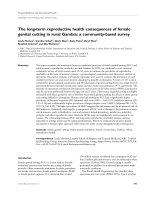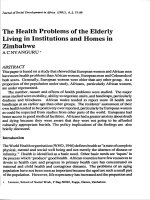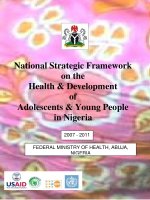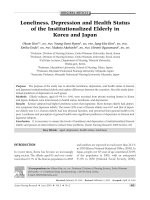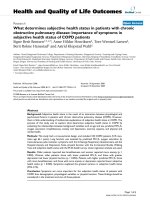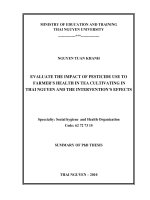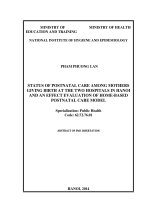Factorspredicting health status of stroke care givers in thai nguyen, vietnam
Bạn đang xem bản rút gọn của tài liệu. Xem và tải ngay bản đầy đủ của tài liệu tại đây (5.01 MB, 232 trang )
FACTORS PREDICTING HEALTH STATUS OF STROKE
CAREGIVERS IN THAI NGUYEN, VIETNAM
NGO XUAN LONG
A THESIS SUBMITTED IN PARTIAL FULFILLMENT
OF THE REQUIREMENTS FOR
THE DEGREE OF DOCTOR OF PHILOSOPHY
(NURSING)
FACULTY OF GRADUATE STUDIES
MAHIDOL UNIVERSITY
2017
COPYRIGHT OF MAHIDOL UNIVERSITY
Thesis
entitled
FACTORS PREDICTING HEALTH STATUS OF STROKE
CAREGIVERS IN THAI NGUYEN, VIETNAM
………………………………………………..
Mr. Ngo Xuan Long
Candidate
………………………………………………...
Assoc. Prof. Dr. Wanpen Pinyopasakul,
Ph.D (Nursing)
Major Advisor
………………………………………………...
Assoc. Prof. Dr. Kanaungnit Pongthavornkamol,
Ph.D (Nursing)
Co-advisor
…………………………………………………
Assist. Prof. Dr. Rungnapa Panitrat,
Ph.D (Nursing)
Co-advisor
…………………………………..
Prof. Patcharee Lertrit,
MD., Ph.D (Biochemistry)
Dean
Faculty of Graduate Studies
Mahidol University
…………………………………………………
Prof. Rutja Phuphaibul
Ph.D (Nursing)
Program Director
Doctor of Philosophy of Nursing
Faculty of Nursing & Faculty of Medicine
Ramathibodi Hospital
Mahidol University
Thesis
Entitled
FACTORS PREDICTING HEALTH STATUS OF STROKE
CAREGIVERS IN THAI NGUYEN, VIETNAM
Was submitted to the Faculty of Graduate Studies, Mahidol University
For the degree of Doctor of Philosophy (Nursing)
on
August 30, 2017
…………………………………………
Ngo Xuan Long
Candidate
………………………………………………..
Assoc. Prof. Dr. Manee Arpanantikul
Ph.D (Nursing), Chair
………………………………………………...
Assoc. Prof. Dr. Wanpen Pinyopasakul
Ph.D (Nursing), Member
………………………………………………...
Assoc. Prof. Dr. Kanaungnit Pongthavornkamol
Ph.D (Nursing), Member
…………………………………………………
Assist. Prof. Dr. Rungnapa Panitrat
Ph.D (Nursing), Member
…………………………………………………
Assoc. Prof. Dr. Siriphan Sasat
Ph.D (Nursing Studies Gerontology),
(Faculty of Nursing, Chulalongkong
University), Member
…………………………………..
Prof. Patcharee Lertrit, MD.
Ph.D (Biochemistry)
Dean, Faculty of Graduate Studies
Mahidol University
…………………………………………………
Prof. Dr. Rutja Phuphaibul
Ph.D (Nursing)
Program Director
Doctor of Philosophy Program in Nursing
(International and Collaborative with Foreign
University Program)
Faculty of Medicine Ramathibodi Hospital
School of Nursing Ramathibodi Hospital
Mahidol University
Fac. of Grad. Studies, Mahidol Univ.
Thesis / v
FACTORS PREDICTING HEALTH STATUS OF STROKE CAREGIVERS IN THAI
NGUYEN, VIETNAM
NGO XUAN LONG 5736975 NRNS/D
Ph.D. (NURSING)
THESIS ADVISORY COMMITTEE: WANPEN PINYOPASAKUL, Ph.D. (NURSING),
KANAUNGNIT PONGTHAVORNKAMOL, Ph.D. (NURSING), RUNGNAPA PANITRAT,
Ph.D. (NURSING)
ABSTRACT
The number of stroke survivors requiring family care in Vietnam have been rising
dramatically. This study aimed to examine health status of stroke caregivers, and identify
whether caregiver's age, caregiver's income, patient's functional status, caregiver burden, social
support, and family conflict could predict health status of the Vietnamese stroke caregivers. A
descriptive study was conducted in Thai Nguyen National General Hospital, Vietnam from
December 2016 to March 2017. A total of 126 stroke caregivers were recruited from three
outpatient clinics in the hospital. Data were collected by using a demographic questionnaire, the
Modified Barthel Index, Zarit Burden Interview Scale, Multidimensional Scale of Perceived
Social Support, Family Caregiver Conflict Scale, and the Short Form-36 Health Survey.
Descriptive statistics and stepwise multiple regression were employed to analyze the data.
The findings revealed that the majority of stroke caregivers were females
(71.4%). Most of them were married (92.2%), and more than half were related to stroke
patients as their spouses (53.3%). Overall, the health status of stroke caregivers was at a
moderate level. Caregiver burden, patient’s functional status, caregiver’s age, and social
support together explained 80.3% of variations in the health status of stroke caregivers
(R2 = .803). Caregiver burden was the strongest predictor of health status of these
caregivers (β = -.56.7, p < .001).
Based on the findings, nurses should take caregiver’s age, functional status of
stroke survivors, caregiver burden, and social support into consideration when preparing
family caregivers to provide care for stroke survivors. To reduce perceived caregiver burden,
family support interventions are greatly suggested to enhance heath status of the Vietnamese
stroke caregivers.
KEY WORDS: STROKE CAREGIVER/ HEALTH STATUS/ VIETNAM
222 pages
vi
CONTENTS
Page
ACKNOWLEDGEMENTS
iii
ABSTRACT
v
CONTENTS
vi
LIST OF TABLES
x
LIST OF FIGURES
xi
CHAPTER I INSTRODUCTION
1
1.1 Background and Significance of the Study
1
1.2 Research Questions
8
1.3 Purposes of the Study
8
1.4 Research Hypotheses
9
1.5 Research Framework
9
1.6 Scope of the Study
12
1.7 Expected Outcome and Benefits
12
1.8 Definition of Terms
13
CHAPTER II LITERATURE REVIEW
2.1 Stroke or Cerebrovascular Disease
14
15
2.1.1 Description of stroke
15
2.1.2 Prevalence and incidence of stroke
17
2.1.3 Risk factors of stroke
19
2.1.4 Impacts of stroke on stroke patients
20
2.2 Overview of Vietnam and Stroke Care in Vietnam
22
2.2.1 Description of Vietnam and Thai Nguyen
22
2.2.2 Health care system in Vietnam
24
2.2.3 Stroke care in Vietnam
28
2.3 Family Caregivers of Stroke Patients
30
2.3.1 Definitions of family caregiver of stroke patients
30
2.3.2 Effects of caregiving on caregiver of stroke patients
32
vii
CONTENTS (cont.)
Page
2.4 Health Status of Stroke Caregivers
34
2.4.1 Concepts of health status
34
2.4.2 Measurements of health status
36
2.4.3 Studies of health status of stroke caregivers
40
2.5 The Theoretical Framework
46
2.5.1 The conceptualization of factors influencing caregiving outcomes
46
2.5.2 The selection of theoretical framework
47
2.5.3 Stress-Appraisal model
49
2.5.4 Studies used Stress-Appraisal model
53
2.6 Factors Associated with Health Status of Stroke Caregivers
55
2.6.1 Characteristic of stroke caregivers
56
2.6.2 Patient’s functional status
58
2.6.3 Caregiver burden
59
2.6.4 Social support
61
2.6.5 Family conflict
64
2.7 Conclusion
CHAPTER III METHODOLOGY
66
67
3.1 Research Design
67
3.2 Population and Sampling
67
3.3 Sample Size
68
3.4 Setting
69
3.5 Research Instruments
70
3.6 Protection of Human Subjects
77
3.7 Data Collection Procedure
78
3.8 Data Analysis
80
CHAPTER IV RESULTS
82
4.1 Characteristics of Stroke Caregivers and Stroke Patients
82
4.2 Description of Health Status of Stroke Caregivers
89
viii
CONTENTS (cont.)
Page
4.3 Description of Patient’s functional status, Caregiver Burden,
Social Support, Family Conflict
90
4.4 Relationship between Caregiver’s Age, Caregiver’s Income, Patient’s
Functional Status, Caregiver Burden, Social Support, Family Conflict
and Health Status of Stroke Caregiver
4.5 Prediction of Health Status of Stroke Caregiver
CHAPTER V DISCUSSION
98
101
103
5.1 Demographic Characteristics of Family Caregivers
103
5.2 Demographic Characteristics of Stroke Patients
106
5.3 Levels of Health Status of Stroke Caregivers
107
5.4 Factors Predicting Health Status of Stroke Caregivers
109
5.5 Conclusion
121
5.6 Strengths and Limitations of the Study
122
CHAPTER VI CONCLUSION AND RECOMMENDATIONS
124
6.1 Conclusion of the Study
124
6.2 Recommendations
126
REFFERENCES
128
APPENDICES
157
Appendix A List of Experts for Content Validity
158
Appendix B List of Instrument Translators
159
Appendix C IRB Approval
160
Appendix D Letters for Asking Permission for Data Collection
161
Appendix E Hospital Permission for Data Collection
163
Appendix F Permission for Using Instruments
165
Appendix G Research Instruments (English Version)
174
Appendix H Participant Information Sheet
193
Appendix I Consent Form
195
Appendix J Research Instruments (Vietnamese Version)
197
ix
CONTENTS (cont.)
Page
Appendix K Testing Assumption of Multiple Regression Analysis
BIOGRAPHY
219
222
x
LIST OF TABLES
Table
Page
3.1
The constant C related to error type I and type II
69
4.1
Demographic characteristics of family caregivers
83
4.2
Information related to the caregiving situation
85
4.3
Demographic characteristic of stroke patients
87
4.4
Range, mean and standard deviation of health status of stroke caregivers
90
4.5a Frequency, percentage, range, mean and standard deviation of activities
of daily living
4.5b Mean and standard deviation of activities of daily living of stroke patients
91
91
4.6a Frequency, percentage, range, mean and standard deviation of
caregiver burden
4.6b Mean and standard deviation of caregiver burden
92
93
4.7a Frequency, percentage, range, mean and standard deviation of social
support
4.7b Mean and standard deviation of social support
95
95
4.8a Frequency, percentage, range, mean and standard deviation of
family conflict
4.8b Mean and standard deviation of family conflict
4.9
96
97
Relationship between caregiver’s age, caregiver’s income and health
status of stroke caregivers
99
4.10 Relationship between patient’s functional status, caregiver burden,
social support, family conflict and health status of stroke caregivers
100
4.11 Correlation matrix and correlation between predictors and health status
of stroke caregivers
100
4.12 Stepwise Multiple Analysis summary of variables predicting health
status of stroke caregivers
102
xi
LIST OF FIGURES
Figure
Page
1.1
Research framework
12
2.1
The map of Vietnam
23
2.2
Structure of the Vietnamese health care system
27
2.3
The conceptual model of Yates et al. (1999)
52
2.4
Conceptual-Theoretical-Empirical structure of the study
53
3.1
The SF-36 measurement model of Ware et al. (1994)
76
Fac. of Grad. Studies, Mahidol Univ.
Ph.D. (Nursing) / 1
CHAPTER I
INTRODUCTION
1.1 Background and Significance of the Study
Stroke or cerebrovascular disease is called a “brain attack”. It refers to an
intracerebral hemorrhage or interruption of blood flow to the brain, resulting in
transient or permanent neurological injury or death (American Heart Association,
2014). Stroke is a leading cause of death and long-term impairments and disabilities
(Mukherjee & Patil, 2011; Roger et al., 2012). It poses the high levels of strain,
perceived burden, anxiety, and dissatisfaction with life of caregivers (Gillespie &
Campbell, 2011). The World Health Organization (WHO) (2014) found that more than
15 million new stroke cases annually in the world, with a total about 5 million people
permanently disabled, 87 % occurred in low and middle-income countries like
Vietnam. In America, approximately 795,000 persons experience a stroke each year
(American Heart Association, 2014), while in Europe, the annual standardized
incidence for stroke varied from approximately 141 to 373/100,000 population per
year (Vasiliadis, 2013). Additionally, stroke has been among the top 4 leading causes
of death in Asia area (Kim, 2014). In the context of Vietnam, the number of patients
with stroke is constantly increasing each year (Tirschwell et al., 2012). Basing on
document of internal circulation only in 115 hospital of People of Ho Chi Minh
showed that there were 1,210 patients admitted to the hospital with stroke in 2005, and
this figure was increased to appropriate 8,000 patients in 2013 (Chuong et al., 2013).
Most recently, the Ministry of Health of Vietnam (MOH) (2013) found that in 2013
about 230,000 stroke cases annually accounting for 110,000 deaths and 1.7 disabilityadjusted life years (DALYs) lost, and its estimated cost for the Vietnamese health
system was US$ 48 million per year.
Stroke can affect individuals of any age, but it largely affects the elderly
(Meschia et al., 2014). A report of Go and colleagues (2014) showed that about 75%
of stroke patients are 65 years old and older (Go et al., 2014). Thinh and colleagues
Ngo Xuan Long
Introduction / 2
(2008) conducted a research entitled "National hospital survey of stroke care in
Vietnam" and found that about 62.4 % of stroke patients are 60 years old and over.
According to the General Statistics Office Vietnam (2013), the older population in
Vietnam is expected to increase. In 2009, people aged over 60 comprised nearly 6.4%
of the population (7.66 million in a population of 85.80 million), and this proportion is
predicted to increase to 11.64% of 96.18 million by 2020. The rapid growth in the
number of older people also leads to the prevalence rate of stroke patients greatly
increasing in the Vietnamese society.
Although advances in the stroke treatment, rehabilitation, and health care,
40% to 60% stroke survivors experienced moderate-to-severe disabilities (loss of
mobility, impaired speech, and cognitive impairment) that require the special
rehabilitative care (Go et al., 2014; Jaracz et al., 2014; Skibicka et al., 2010). CarodArtal and Egido (2009) determined that a lot of stroke survivors have experienced
significant hemiparesis (50%), inability to walk without support (30%), dependence in
activities of daily living (ADL) (26%), motor aphasia problem (19%), and depressive
symptoms (35%). Noticeably, approximately 40% stroke survivors have limited
achievement in approach rehabilitation goals associated to movement and
communication (Ostwald et al., 2009). As a result, stroke survivors really depend on
their families for ongoing care at home. Numerous studies have estimated that up to 6080% of stroke survivors who are discharged from the hospital will return home and
require long-term care from family caregivers to gain optimal recovery post discharge
(Costa et al., 2015; Hayashi et al., 2013; Niyomthai et al., 2010; Tirschwell et al., 2012).
The effect of a stroke diagnosis not only impacts the person with the
disease, but also leads to several issues for their family caregivers, their family
members, communities and society (Baumann et al., 2011; Costa et al., 2015). The
gravity of this impact is because the majority of supports (physically and mentally) for
stroke patients in their home came from their family members. Family members of
people with stroke survivors usually experience more stressors directly and indirectly,
and quality of life is lower than the general population, with higher risks of depression
(Chen & Botticello, 2013). Caregivers of people with stroke survivors carry the entire
caregiving burden, and as a consequence, they suffer with physical health
consequences and financial hardship (Bhattacharjee et al., 2012). Stroke caregivers
Fac. of Grad. Studies, Mahidol Univ.
Ph.D. (Nursing) / 3
also experienced a significant lower health status, as evidenced by momentous
decreases in the social functioning dimension (Guo & Liu, 2015; Nelson et al., 2008).
In addition, stroke caregivers have been known to experience limitation leisure
activities, poorer emotional function compared to the caregivers of patients with
neurological disorders. (Bulley et al., 2010; Chow, Wong, & Poon, 2007).
Family caregivers, therefore, play an important role to provide support,
physically, psychologically, and financially for stroke survivors. The literature showed
that providing care to stroke survivors with poor health conditions may cause many
difficulties to the family caregivers and limitation in performing self-care. (Baumann
et al., 2011; Choi-Kwon et al., 2005; Lutz et al., 2011; Tsai et al., 2015). According to
Asiret and Kapucu (2013), caring for stroke survivors is not limited to the personal
care as bathing, dressing, feeding, but includes administering medication, financial
management, encourage the sense, planning social services, sharing finances and
house. As a result, the caregivers can affect their emotional, physical, mental, and
social well-being.
Worldwide, many studies have reported a decline in physical health and an
increase in psychological strain and fatigue of caregivers of stroke patients since
undertaking caregiving role (Carod-Artal et al., 2009; Em et al., 2017; Kruithof et al.,
2016; Parag et al., 2008; Vincent et al., 2009). In addition, previous studies related to
family caregivers of stroke survivors also have shown that providing long-term care
for stroke patients may be a source of chronic stress, disruption in family routines, the
changes in their daily living and many other negative consequences (Denno et al.,
2013; Greenwood et al., 2008; Pang, 2014; Rigby, Gubitz, & Phillips, 2009).
According to Franzen-Dahlin and colleagues (2007), spousal caregivers of stroke
survivors have been shown to be more stressful than other informal caregivers.
Increased strain may be related to physical and psychological exhaustion as well as
emotional demands of caregiving on the health of caregivers. Baumann and colleagues
(2011) noted that the disruption in family routines, changes in daily living, and
increased strain of stroke caregivers was caused by dedicating more time and energy
to help improve the conditions of stroke patients after they discharge from the hospital
to their home. For this reason, stroke caregivers may suffer health problems as a direct
Ngo Xuan Long
Introduction / 4
result from tend to overlook taking care for themselves (Asiret & Kapucu, 2013;
Baumann et al., 2011; McCullagh et al., 2005; Ogunlana et al., 2014).
By and large, in the health literature, health status is increasingly referred
to as health-related quality of life (HRQoL) (Bowling, 2013). Health-related quality of
life, like as a subjective sense of well-being or like subjective health status, is defined
as a broad, multidimensional construct referring to those aspects of people’s lives that
relate to their health (Salter et al., 2008). From a health viewpoint, HRQoL has been
said to refer to the optimal levels of physical, mental, role (e.g. worker, caregiver,
parent, etc.) and social functioning, including relationships, life satisfaction,
perceptions of health, capability, and well-being, mirroring the World Health
Organization's (WHO, 1946) definition of health as “a state of complete physical,
mental, and social well-being and not merely the absence of disease or infirmity”, and
as the impact of disease and treatment on disability and daily functioning (Bowling,
2013). In the review, there is a great deal of overlap in the definitions of health status
and health-related quality of life (Breek et al., 2005; Zubaran et al., 2008). In this
study, health status refers to caregiver’s perception of their own health involving
physical, mental, and functional well-being (Ware & Sherbourne, 1992).
Several reviews of existing research on health status of stroke caregivers
have notified that most of the caregivers evolve health problems during to carry out
their caregiving duties (Balhara et al., 2012; Carod-Artal et al., 2009; Persson et al.,
2015; Watanabe et al., 2015). Persson and colleagues (2015) found that the husbands
and wives of stroke survivors often endure long-term physical and mental health
problems. Asiret and Kapucu (2013) found that caregivers experienced some physical
health problems such as stomach ulcer (27.7%), disc herniation (38.3%), and headache
(17%) as a result of caring for stroke survivors. They said that caregivers perceived
physical health problems were related to completing their duties (47.8%), and their
sadness and stress (63.6%). Watanabe and colleague (2015) found that 60% of
caregivers had difficulty mentally relaxing and about 52% to 55% of stroke caregivers
suffer some forms of emotional distress (Tang et al., 2011). In addition, approximately
50% of caregivers of stroke patients reported greatly less time for social activities and
leisure time such as outings with friends or visiting somewhere (Parag et al., 2008).
Fac. of Grad. Studies, Mahidol Univ.
Ph.D. (Nursing) / 5
Upon describing the long-term consequences disabilities of stroke survivors
encounters their daily living. The family caregivers played caregiving role extremely
important and also a pivotal role in a long period of time recovery and rehabilitation of
stroke patients. However, this caregiving role can make more stressful and increase
burden on caregivers and it, simultaneously, can affect a negative physical and
psychological consequence on stroke caregivers' well-being (Ogunlana et al., 2014).
According to literature review, many factors associated with health status
of stroke caregivers have been identified. Several stress variables related to health
status of stroke caregiver have been recognized by individual characteristics of
caregivers such as age, income, gender, educational level (Carod-Artal et al., 2009;
Godwin et al., 2013) and characteristics of patients such as functional status, cognitive
impairment, depression (Nelson et al., 2008; Othman et al., 2014). In addition, many
researchers who conducted quantitative studies also indicated that caregiver burden
(Carod-Artal et al., 2009; Chang et al., 2010; Zorowitz, Gillard, & Brainin, 2013),
social support (Lui et al., 2012; Pellerin, Rochette, & Racine, 2011), caregiver
depression (Balhara et al., 2012; Chen & Botticello, 2013), coping strategies (Yu et
al., 2013), and family conflict (Clark et al., 2004; Kwak, Ingersoll-Dayton, & Kim,
2012) influenced health status of stroke caregivers. In this study, the researcher
focused on examining factors including: 1) caregiver’s age, 2) caregiver’s income, 3)
patient’s functional status, 4) caregiver burden, 5) social support, and 6) family
conflict as they are potentially predicted health status of stroke caregivers in Vietnam.
The characteristic of caregiver such as age was found affected health status
of stroke caregivers. Godwin and colleagues (2013) conducted a study with 159
survivors of stroke and their spousal caregivers, and they found that older age were
associated with lower physical health of caregiver. Carod-Artal et al. (2009) also found
that caregiver’s age significantly correlated (p = 0.001) with health status of stroke
caregivers measured by EuroQol-5D. Nelson et al. (2008) and Huang et al. (2009) said
that increased caregiver’s age were associated and predicted decreased health of stroke
caregiver. Interestingly, Yu et al. (2013) and McCullagh et al. (2005) found that there
was no relationship between caregiver’s age and physical component summary and
mental component summary of stroke caregivers.
Ngo Xuan Long
Introduction / 6
Apart from age, caregiver’s income is also related to the health status of
stroke caregivers. Yang and colleague (2012) showed that lower household income and
loss of employment due to caregiving added to caregivers’ susceptibility and
vulnerability to perceive the weight of the burden and finally result in reduced
physical health of caregiver (Yang et al., 2012). Huang and colleagues (2009)
conducted a study with 103 informal caregivers in Taiwan. They showed that
caregivers who had lower household incomes had the more depressive symptom lead
to decrease mental health. This is appropriate with the findings from the study
investigated by Saunders (2010). However, Yu and colleagues (2013) found that
caregiver income was not associated with caregiver’s health status.
According to Yu et al. (2013), the level of decrease in functional status of
stroke patients was negatively influenced in caregiver’s health status. Caregivers deal
with a lot of difficulties caused by assisting stroke patients with their severe
disabilities and poor cognition (Hung et al., 2012; Othman et al., 2014). Van Heugten
et al. (2006) said caring for stroke survivors is not limited to eating, sleeping, bathing,
displacing, but includes financial management, arranging the environment for safety,
encourage the sense or emotional support when stroke patients are moody, aggressive.
As a result, the caregivers intensify responsibilities and increase burdens if caregivers
are unable to arrange resources and time appropriately, they may have more and more
accumulations the stressful and pressure, leading to depression, anxiety, lack of take
care for themselves, not maintain bodily balance, and exhaustion all of which could
affect their health status (Vincent et al., 2009). Interestingly, Carod-Artal and
colleagues (2009) found no significant patient’s functional status with perceived health
status of stroke caregivers. Nelson et al. (2008) also noted that declining patient
neurological functioning did not predict health status of stroke caregivers.
Burden of care of stroke patients impacts the physical as well as
psychological well-being of the caregiver adversely (Das et al., 2010; Gbiri, Olawale, &
Isaac, 2015; Kumar, Kaur, & Reddemma, 2015). One major cause developed health
problems of caregiver is the burden. In the literature review, the large research on family
stroke caregivers has consistently demonstrated that increased burden of caregivers
relates to decreasing their mental and physical health (Akosile et al., 2011; Kumar et al.,
2015; Martinez-Martin et al., 2008; Morimoto, Schreiner, & Asano, 2003), particularly
Fac. of Grad. Studies, Mahidol Univ.
Ph.D. (Nursing) / 7
among stroke caregivers (Carod-Artal et al., 2009). Rittman and colleagues (2009)
found that reduced physical and mental health of caregiver is associated with great
caregiver burden. This finding is consistent with previous reports in developed countries
(Akosile et al., 2011) and other cultural settings (Asiret & Kapucu, 2013).
Previous studies also have shown that the positive effects on social
support, which includes emotional support and physical help, on psychological wellbeing of caregivers (Clay et al., 2013; Cumming et al., 2008; Kuscu et al., 2009;
Pesantes et al., 2017). However, the relationship between caregiver's physical health
and social support is not clearly documented in the literature (Chen et al., 2010; Yu et
al., 2013). Kuscu and colleagues (2009) found that perceived social support associated
with psychological well-being of family caregivers. In addition, a study in Taiwan said
that family support was a significant predictor of caregiver's health status (Yeh &
Chang, 2012). Interestingly, Yu et al. (2013) recruited 121 caregivers of stroke
survivors in China to study the correlation of social support and caregiver's health
status. The researchers found that social support had no direct effect on the health
status of stroke caregivers. This result is consistent with the findings from study
conducted by Gräsel et al. (2005) and Chen et al. (2010).
The shifts of roles of family members for stroke patients and disruptions in
interpersonal relationships can undermine family stability, potentially resulting in
family conflict and other signs of family stress (Kwak et al., 2012; Scharlach & Dalvi,
2006). Besides, caregivers may also experience stress caused by being confused about
their roles as they lack knowledge or skills in caregiving, or they may play too many
roles, which leads to conflicts with other relatives or family members due to
incongruent needs (Clark et al., 2004). This affects their daily living, occupation,
social participation, and economic status, and it can bring about changes in health
status of stroke caregivers (Clark et al., 2004).
Currently, there is limited knowledge about the health status among
Vietnamese family caregivers of stroke patients. Essentially, maintaining or improving
health status of stroke caregivers is important in management of families of people with
stroke. The issues of health status of stroke caregivers remain unaddressed within the
Vietnam health care system. Noticeably, there are many studies conducted in the West
and in some Asian countries such as American, Brazil, Sweden, India, Japan, Thailand,
Ngo Xuan Long
Introduction / 8
and China affirming the existence of health problems among caregivers of patients with
stroke (Costa et al., 2015; Kumar et al., 2015; Pai & Tsai, 2016; Persson et al., 2015;
Savini et al., 2015; Watanabe et al., 2015). However, most of these investigations have
been conducted outside Vietnam. It still remains a big gap of understanding regarding
health status of stroke caregivers and its associated factors between Vietnamese
caregiver with stroke survivors. Lack of knowledge and understanding regarding these
issues is one of the barriers that could impede health care providers, nurses in particular,
from providing effective care to both caregivers and their care recipients. Understanding
the factors that predicting health status of stroke caregivers would help health care
providers identify and develop the interventions program to target caregivers at risk for
physical or mental health problems.
1.2 Research Questions
The research questions guiding this study were as follows:
1. What is the level of health status of stroke caregivers in Thai Nguyen,
Vietnam?
2. Are caregiver’s age, caregiver’s income, patient’s functional status,
caregiver burden, social support, family conflict the predictors of health status of
stroke caregivers in Thai Nguyen, Vietnam?
1.3 Purposes of the Study
The purposes of this study were as follows:
1. To describe the health status of stroke caregivers in Thai Nguyen,
Vietnam.
2. To investigate the influence of caregiver’s age, caregiver’s income,
patient’s functional status, caregiver burden, social support, family conflict on health
status of stroke caregivers in Thai Nguyen, Vietnam.
Fac. of Grad. Studies, Mahidol Univ.
Ph.D. (Nursing) / 9
1.4 Research Hypotheses
The hypotheses for this study were as follows:
1. Caregiver’s age, caregiver’s income, patient’s functional status,
caregiver burden, social support, and family conflict are associated with health status
of stroke caregivers in Thai Nguyen, Vietnam.
2. Caregiver’s age, caregiver’s income, patient’s functional status,
caregiver burden, social support, and family conflict can co-predict health status of
stroke caregivers in Thai Nguyen, Vietnam.
1.5 Research Framework
This study was guided by a Stress-Appraisal Model (SAM) of Yates,
Tennstedt, and Chang (1999). Yates and colleagues (1999) have developed this model
based on the background of both the Stress Process Model presented by Pearlin and
colleagues (1990) and the Appraisal Model developed by Lawton and colleagues
(1989, 1991). The Stress Process Model (SPM) of Pearlin and colleagues (1990) is
derived from caregiver stress as a consequence of a caring process for individual with
Alzheimer's disease. The model focuses attention on the ways in which potentially
stressful occurrences interact with each other and with intervening factors, such as
personal or environmental resources, to intensify, and sometimes to reduce, stress
effects and determine health outcomes for the caregiver. The relationships between
factors and stress are evaluated in terms of changing and developing over time. The
model has four major factors, each of which is made up of multiple components:
contextual or background information, stressors, mediators, outcomes. Pearlin and
colleagues (1990) indicated that burden is viewed as “subjective primary” stressor and
affected by background and contextual variables of caregivers such as age, gender,
educational level, socioeconomic characteristics, and caregiving history. Burden in
this model acts as an independent and predictive variable. It has directly affected
outcomes such as physical and mental health of caregiver, besides, indirectly through
secondary stressor (family conflict, economic problems, self-esteem, and competence).
The mediators such as coping and social support may serve both to lessen the effected
Ngo Xuan Long
Introduction / 10
of stressors and to block contagion of stressors and explain different outcomes
experienced by caregivers in dissimilar ways.
The Appraisal Model, which was fundamental to the SAM, was developed
by Lawton and colleagues (1989, 1991). This model was developed based on Stress,
Appraisal, and Coping model of Lazarus and Folkman (1984). The researchers
designed the model focuses on the relationships of stressors and resources of negative
caregiving appraisal among caregivers. Caregiving appraisal in the model involves
caregivers, psychological factors, care receivers, and other environmental that has
been viewed as a dynamic process. The researchers grouped subjective and
interpretive variables together into the category of “appraisal”. Then, they added this
appraisal factor to the basic factors of the stress model. They defined that caregiving
appraisal refers to “all cognitive and affectional appraisals and reappraisals of the
potential stressor and the efficacy of one’s coping effort”.
Yates and colleagues (1999) built on the strengths of both the stress and
appraisal model. Several modifications of Pearlin et al. (1990) model has been made to
incorporate adaptations derived from the Lawton et al. (1989, 1991) model. A
modification from the stress process model of Pearlin and colleagues (1990) considers
"overload" in primary stressor as a secondary appraisal in Yates and colleagues
(1999). The caregivers, in determining their levels of overload, have assessed their
own situations and determined how they feel about it. As such, overload can be
compared to what others have called subjective burden, and can be defined as the
feeling expressed by the caregiver in regard to energy level, satisfaction with the level
of care provided and having enough time to do everything necessary, including time
for one’s self (Pearlin et al., 1990).
The model of Yates et al. (1999) attempted to integrate both these models
in an approach which evaluated caregiver outcomes. In the model, the authors
emphasize the appraisal of caregivers in the stressful situations and their responses to
the stressful situations and taking account of their coping resources available. This
model includes five domains: primary stressors, primary appraisal, mediators,
secondary appraisal, and outcome. In each domain comprises multiple components.
The first is the primary stressors measure of need for care: cognitive impairments,
problem behaviors, and functional disability. The second is the primary appraisal
Fac. of Grad. Studies, Mahidol Univ.
Ph.D. (Nursing) / 11
represent both objective measures of caregiving work and subjective appraisal of
caregiver: hours of informal care provided. The third is mediators or resources:
personal and social resources mitigate an effect of stressors, formal services,
emotional support, and relationship with the care receiver, caregiver feelings of
mastery. The fourth is the secondary appraisal represents the perception of caregiver in
daily caregiving experiences as overloaded or burden. The fifth is an outcome:
caregiver well-being related to depression.
According to literature review, previous researchers have used Stress
Appraisal Model as a framework in their studies. Casado and Sacco (2011) conducted
a study to identify the correlation between caregiver burden and some factors such as
family-support network, self-efficacy of care management.
They used a Stress-
Appraisal Model of Yates et al. (1999) for guiding their study. Similarly, Chappell and
Reid (2002) investigated burden and well-being among caregivers for dementia in
British Columbia, Canada and used Yates and colleagues (1999) model as a
framework to support for their study.
In this study, the researcher examined the relationship among variables
and using the model of Yates et al. (1999) and literature review as a conceptual
framework including: background and context (caregiver’s age, caregiver’s income);
primary stressor (patients’ functional status); mediators (social support and family
conflict); secondary appraisal (caregiver burden) and health status of stroke caregivers
in Yates et al. (1999) as a caregiving specific distress outcome. The researcher
hypothesizes that background and context, primary stressor, secondary appraisal, and
mediators were associated with health status of stroke caregivers (Figure 1.1).
Ngo Xuan Long
Caregiver’s
age
Caregiver’s
income
Introduction / 12
Patient’s
functional
status
Social
support
Caregiver
burden
Family
conflict
Health
status of
stroke
caregivers
Figure 1.1 Research framework
1.6 Scope of the Study
This study examined health status of stroke caregivers and investigating
the effect of caregiver’s age, caregiver’s income, patients’ functional status, social
support, caregiver burden, family conflict on health status of stroke caregivers. Data
were collected from both male and female family caregivers, aged 18 years and over,
who provided care to patients with stroke recruited from Neurological Clinic and
Outpatient Department Unit as well as Department of Rehabilitation at Thai Nguyen
National General Hospital in Thai Nguyen province, Vietnam. The researcher
collected data from November 2016 to February 2017.
1.7 Expected Outcomes and Benefits
The findings were expected to provide the understanding of factors that
influence health status of stroke caregivers in order to help health care providers
identify and develop an effective intervention program to target reducing the risk
factors effect on physical or mental health of caregivers of stroke patients. In addition,
the findings from this study contributed to knowledge development in nursing science.
Fac. of Grad. Studies, Mahidol Univ.
Ph.D. (Nursing) / 13
1.8 Definition of Terms
The definitions of variables examined in this study can be summarized as
follows:
Health status refers to stroke caregiver’s perception of their own health
status involving physical, mental, and functional well-being as assessed by using the
Short-Form Health Survey (SF-36) designed by Ware and Sherbourne (1992).
Caregiver burden refers to a stroke caregiver’s subjective perception of
overload in one or more of the four perspectives of physical, psychological, social, and
financial spheres through the caregiving process. Caregiver burden was evaluated in
this study as the score achieved by the caregiver on the Zarit Burden Interview (ZBI)
(Zarit et al., 1985).
Caregiver’s age refers to the length of time that stroke caregiver has been
alive, measured in years. It was calculated by minus the present year with the year of
birth. It was measured by demographic characteristics questionnaire.
Caregiver’s income refers to the amount of money in Vietnam dong
calculated to the (US$) that a stroke caregiver received per month. It was measured by
demographic characteristics questionnaire.
Patients’ functional status refers to the ability of stroke patients to
perform activities of daily living such as bathing, dressing, and other independent
living skills. Activities of daily living include the ability to be mobile, dress, feed,
keep oneself clean and perform toileting functions. Functional status defined in this
study as the score obtained on the Modified Barthel Index (MBI), by Shah et al.
(1989).
Family conflict refers to a disagreements within the larger family system
about various issues and/or needs (physical or emotional) arising during stroke
recovery (Clark et al., 2003). Family conflict in this study was measured by using
Family Caregiver Conflict Scale (FCCS), developed by Clark and colleagues (2003).
Social support refers to the availability of emotional, practical, and
informational support from family and friends, and health care providers in relation to
the care for stroke patients as caregivers received. Social support in this study was
measured by using Multidimensional Scale of Perceived Social Support (MSPSS),
developed by Zimet et al. (1988).
Ngo Xuan Long
Literature review / 14
CHAPTER II
LITERATURE REVIEW
This chapter presents a literature review of the theoretical and empirical
findings relevant to caregiver health status of patients with stroke. Overview about
stroke or cerebrovascular disease, stroke care in Vietnam, caregiver of patient stroke,
health status of stroke caregiver, Stress-Appraisal Model, effects of caregiving on
health status of stroke caregivers, and factors associated with health status of stroke
caregivers was discussed in details as follows:
2.1 Stroke or cerebrovascular disease
2.1.1 Description of stroke
2.1.2 Prevalence and incidence of stroke
2.1.3 Risk factors of stroke
2.1.4 Impacts of stroke on stroke patients
2.2 Overview of Vietnam and stroke care in Vietnam
2.2.1 Description of Vietnam and Thai Nguyen
2.2.2 Health care system in Vietnam
2.2.3 Stroke care in Vietnam
2.3 Family caregivers of stroke patients
2.3.1 Definitions of family caregiver of stroke patients
2.3.2 Effects of caregiving on caregiver of stroke patients
2.4 Health status of stroke caregivers
2.4.1 Concepts of health status
2.4.2 Measurements of health status
2.4.3 Studies of health status of stroke caregivers
2.5 The theoretical framework
2.5.1 The selection of theoretical framework
2.5.2 Stress-Appraisal Model
2.5.3 Studies used Stress-Appraisal Model as a framework
2.6 Factors associated with health status of stroke caregivers
Fac. of Grad. Studies, Mahidol Univ.
Ph.D. (Nursing) / 15
2.6.1 Characteristic of caregiver
2.6.2 Patient‟s functional status
2.6.3 Caregiver burden
2.6.4 Social support
2.6.5 Family conflict
2.7 Conclusion
2.1 Stroke or Cerebrovascular Disease
This section presents description of stroke, prevalence and incidence of
stroke, risk factors of stroke, and impact of stroke on stroke patients.
2.1.1 Description of stroke
Stroke is a term used to describe brain injury caused by an abnormality of
the blood supply to a part of the brain. Stroke is essentially a disease of the cerebral
vasculature in which a failure to supply oxygen to brain cells. Stroke (also called a
cerebral vascular accident) is one of the leading causes of incapacitation. It is caused
by decreased blood flow and subsequent inadequate oxygen supply to part of the brain
leading to tissue damage, which caused neurological manifestations that can affect a
number of body functions. The effects of stroke lie on a continuum from rapid
complete recovery to severe long term disability, or fatality, depending on the severity
of the stroke and the brain region affected. Stroke is related to a number of other
chronic conditions, such as cardiac disease, arteriosclerosis (ischemic vascular
disease), hypertension (high blood pressure), and diabetes (Spence & Barnett, 2012).
The consequences of stroke survivors who do long-term disability leading to the high
amount of stresses and the burden that usually placed on caregivers who are required
to support the stroke survivors through the recovery process and rehabilitation.
The World Health Organization (WHO) (2014) defines a stroke as “rapidly
developing clinical signs of focal (at times global) disturbance of cerebral function,
lasting more than 24 hours or leading to death with no apparent cause other than of
vascular origin”. A stroke should be distinguished from a Transient Ischemic Attack
(TIA) which is defined as a transient episode (symptoms persist for < 24 hours) of
